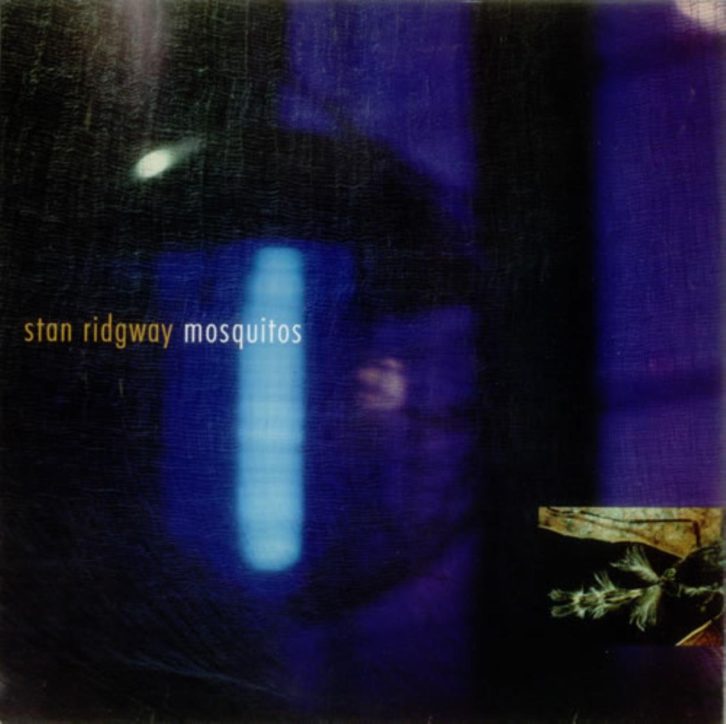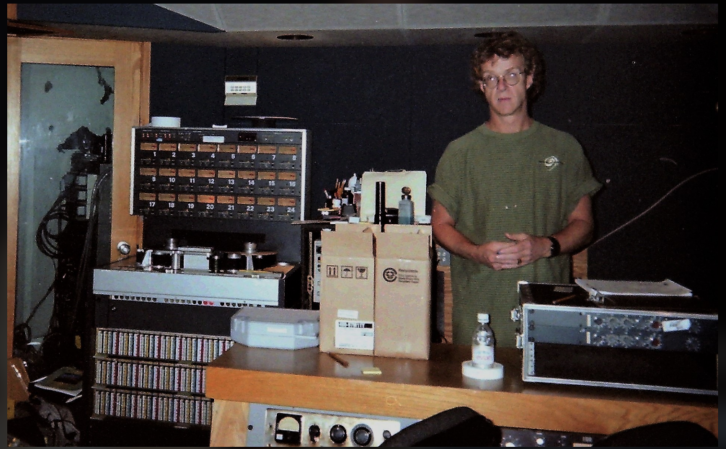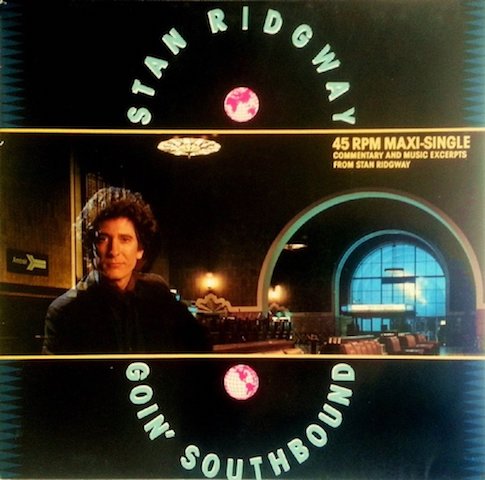
“There’s a big truck waiting tonight at the pier,” and a deal is about to go down in Stan Ridgway’s quirky rock-noir song “Goin’ Southbound.” The third track on Ridgway’s second solo album, Mosquitos, tells a dangerous tale under a full moon that “shines like a big cue ball.”
Adding texture to Ridgway’s story are drummer Denny Fongheiser, Los Lobos’ Steve Berlin on sax; guitarists Ridgway, Eric Williams and special guest Marc Ribot; and synth/drum programmer Jim Lang. But the vintage-cool feel of this dramatic song was originally mapped out by Ridgway, an avowed tinkerer who was an early personal studio owner.
Ridgway’s first success in the music business came with the L.A. Modern Rock band Wall of Voodoo, best known for their song “Mexican Radio” from the 1983 album Call of the West. The song yielded a popular MTV video and rose to Number 58 on Billboard’s Hot 100 chart. Ridgway embarked on a solo career the same year.
He soon after collaborated with Stewart Copeland on music for the movie Rumblefish (1983) and in 1986 released his first solo album, The Big Heat. Most of that debut was produced by Mitchell Froom, but a couple of tracks are credited to another young producer, Joe Chiccarelli, who later produced Mosquitos.
“When Stan started making Mosquitos, he was working with another producer,” Chiccarelli recalls. “They did a few songs and handed them in to Geffen Records, and I don’t think the label was too crazy about the way it turned out. So Stan called me and asked if I would be interested in working on the record, and I said, ‘Yeah, absolutely.’ Our experience in the past was super positive and turned out great. So, we went about starting over with the record.”
Ridgway and Chiccarelli went back to the drawing board in Ridgway’s personal studio, Impala, which the artist had built in a storefront on Burbank Boulevard in North Hollywood. Ridgway had amassed a variety of conventional and electronic instruments, as well as an Allen & Heath console, an Otari tape machine, and an assortment of microphones and outboard gear. Chiccarelli brought along some of his own equipment, as well: Focusrite and Neve preamps, UREI 1176 and LA2A compressors, a pair of Tannoy SGM10B monitors, and various microphones.
Surprisingly, Chiccarelli also contributed to the studio décor. “I’m laughing remembering this,” he says, “because the studio was really dark with brown indoor-outdoor carpeting on the floor and on the walls, too. The whole place was brown, and you could never get enough light in there. Every day that I would drive to that studio, I would stop at a lighting store or a thrift store and I would buy whatever floor lamps or table lamps that I could buy really cheap, because I could never get enough light in the place—it was so dark and depressing. There were something like 16 lamps in there; it was pretty hysterical.”
Building That Noir Sound
Many of the Mosquitos tracks stemmed from demos that Ridgway had created, and he and Chiccarelli built on those ideas gradually, bringing musicians into Impala or moving to a different facility when needed.
“I would say maybe half the record was made from something that Stan started by himself, and about 60 percent of all of the tracks were recorded in Stan’s studio,” Chiccarelli says. “I believe we rented a Telefunken U47 for Stan’s voice. Stan’s vocal would also have been through a Neve 1073 preamp into an LA2A compressor.
“Stan really delivered a great vocal performance,” he continues. “The tricky part of the song was that ‘Goin’ souuuthbound’ line because it’s kind of a howl; the trick was to try to get it just melodic enough but keep the right character in his voice. I remember spending a little extra time trying to get that line.”
On guitars Ridgway and Chiccarelli used a Neumann U87 or Shure SM57 going into the producer’s Focusrite 115 preamps and 1176 or LA3A compression. Another essential part of the film noir-ish sound of the track is Berlin’s sax solo.
“Steve always likes his saxes pretty low-fi,” says Chiccarelli. “So I think we might have done that with a Shure SM57 almost crammed down the bell of the horn. There might have been another mic, though—like a Neumann U47 FET—that was back off the mic and was blended in for more natural tone. But Steve really is a character kind of player. That’s why I love working with him. Los Lobos were into making low-fi records with these sounds that sounded broken and unique, before that was cool. Much credit goes to Mitchell Froom and Tchad Blake for those sounds.
“Stan also loved that low-fi kind of thing,” he adds. “On Mosquitos we tried to make a record that had that sort of kitschy, lo-fi aesthetic but still had a sense of polish and fidelity to it.”
In Impala, drum parts were mapped out electronically, but once several other parts were cut, the project moved to Capitol Studios (Hollywood), where staff engineer Pete Doell recorded Denny Fongheiser’s kit in Studio B.

Drums From Capitol
“I don’t remember many specifics as far as mic choices,” Doell says. “With Joe, we’d always find some novel combination of mics or a different way to process a track, though we had to keep in mind that we might run out of tracks because we were recording to tape. If you felt like you needed another couple of tracks to record a part, the room tracks sometimes had to go and hopefully you’d create something cool with the digital reverb in the mix.
“It helped that Studio B is especially versatile for recording drums, because you can move the mics far enough away to where you could actually hear what the room sounds like,” Doell adds. “So, on almost all the recordings I would do in there, I would record some room tracks, placing mics 20 or 25 feet away sometimes.”
Doell recalls that he captured the drum parts to the studio’s Studer A800 MkIII tape machine, though he says it’s possible the studio had replaced it with an A827 by that point. He used the preamps in the facility’s famed Neve 8068 console.
“It is serial number 001—the actual prototype,” Doell says. “It also had the first Necam automation ever in a console.”
Doell also recorded a string section for the album in Capitol, but “Goin’ Southbound” doesn’t include the full section—just some solo violin, which he captured with a Neuman U67 out in the same live room where they’d recorded drums.
“Then we had Jim Lang do the keyboards at his home studio,” Chiccarelli says. “We especially went to Jim’s studio when we needed more heavily programmed tracks because Jim had an Atari computer. He was way up on the technology of 1989.”
Mixing With Csaba Petocz
 The Mosquitos mix was in Richard Landis’ studio, the Gray Room, equipped with an SSL G+ board and the same Tannoy monitors that Chiccarelli used at the time.
The Mosquitos mix was in Richard Landis’ studio, the Gray Room, equipped with an SSL G+ board and the same Tannoy monitors that Chiccarelli used at the time.
“Richard Landis was an independent producer who was formerly a staff producer at Capitol,” Chiccarelli explains. “He had a lot of hits as a record producer and built a wonderful Vincent van Haaff mix room in his home in Laurel Canyon. He also had Studer tape machines and tons of outboard gear—EMT 250 reverb and 140 plate, Pultec EQs, and AMS reverbs as well.
“My friend Csaba Petocz mixed the record,” Chiccarelli continues. “Csaba and I came up together in the business in the early ’80s as assistant engineers, and we really shared shared the same spirit and sensibilities, but Csaba’s ear was far superior to my ear on certain things, so I brought him in to mix Stan’s album. He was just the best partner in the studio—a great guy with such positive energy. He put his heart and soul into everything.”
Chiccarelli gives Petocz a lot of the credit for balancing the album’s lo-fi factor with the right amount of polish. “I believe we used a GML parametric equalizer on the stereo bus, and the SSL compressor. Part of the sound of the record is [Landis’] SSL console. But it really was Csaba’s sense of fidelity. He was a very musical guy, and he always wanted to keep things authentic and honest. He really helped me focus on priorities. I can hear him with his Australian accent saying, ‘Look, mate, this is the hook. This is the thing that is really, really the key here.’
Chiccarelli looks back somewhat philosophically on these sessions, as they took place at the crossroads of artists beginning to choose personal studios rather than commercial ones, and though Ridgway had a record deal with Geffen, the musicians and production team felt a level of independence that they couldn’t have had if every moment had been spent in commercial facilities on the label’s dime.
“This was when artists were starting to say, ‘I don’t want to be dictated to by the label, or asked where, how, with whom I record,” Chiccarelli says. “I want to do it in a way that is comfortable and not so tense or expensive. Stan wanted to do things in his own way, be able to tinker and experiment and not feel like there was a clock.
“Stan was only trying to be Stan,” Chiccarelli concludes. “He had no desire to copy the trends or have a big smash record. He said what he had to say, and ended up reaching a lot of people. It was such a positive experience for me, because it was really the first time I helped an artist make a record that was for the artist solely, and we didn’t worry about anything the outside world might have to say about it. Despite label pressures—and there were plenty—we just went about it in in our little bubble.”







